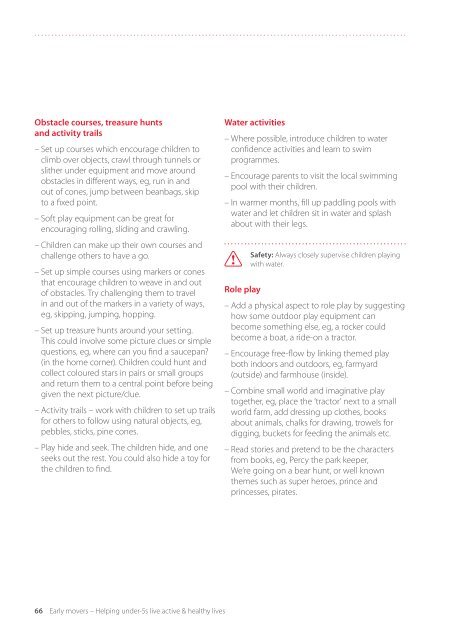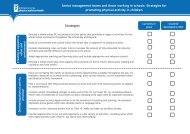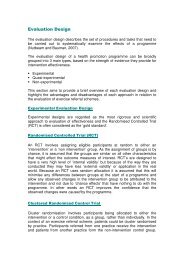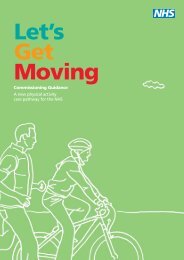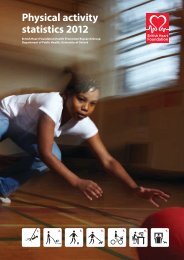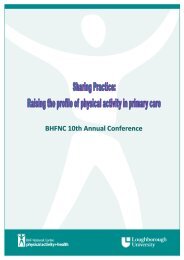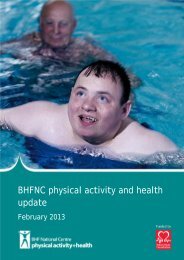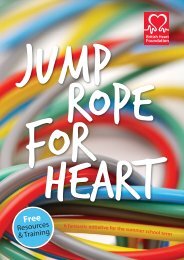5 Practical ideas for physically active play - BHF National Centre ...
5 Practical ideas for physically active play - BHF National Centre ...
5 Practical ideas for physically active play - BHF National Centre ...
- No tags were found...
You also want an ePaper? Increase the reach of your titles
YUMPU automatically turns print PDFs into web optimized ePapers that Google loves.
Developmental activitiesObstacle courses, treasure huntsand activity trails– Set up courses which encourage children toclimb over objects, crawl through tunnels orslither under equipment and move aroundobstacles in different ways, eg, run in andout of cones, jump between beanbags, skipto a fixed point.– Soft <strong>play</strong> equipment can be great <strong>for</strong>encouraging rolling, sliding and crawling.– Children can make up their own courses andchallenge others to have a go.– Set up simple courses using markers or conesthat encourage children to weave in and outof obstacles. Try challenging them to travelin and out of the markers in a variety of ways,eg, skipping, jumping, hopping.– Set up treasure hunts around your setting.This could involve some picture clues or simplequestions, eg, where can you find a saucepan?(in the home corner). Children could hunt andcollect coloured stars in pairs or small groupsand return them to a central point be<strong>for</strong>e beinggiven the next picture/clue.– Activity trails – work with children to set up trails<strong>for</strong> others to follow using natural objects, eg,pebbles, sticks, pine cones.– Play hide and seek. The children hide, and oneseeks out the rest. You could also hide a toy <strong>for</strong>the children to find.Water activities– Where possible, introduce children to waterconfidence activities and learn to swimprogrammes.– Encourage parents to visit the local swimmingpool with their children.– In warmer months, fill up paddling pools withwater and let children sit in water and splashabout with their legs.Role <strong>play</strong> Safety: Always closely supervise children <strong>play</strong>ingwith water.– Add a physical aspect to role <strong>play</strong> by suggestinghow some outdoor <strong>play</strong> equipment canbecome something else, eg, a rocker couldbecome a boat, a ride-on a tractor.– Encourage free-flow by linking themed <strong>play</strong>both indoors and outdoors, eg, farmyard(outside) and farmhouse (inside).– Combine small world and imaginative <strong>play</strong>together, eg, place the ‘tractor’ next to a smallworld farm, add dressing up clothes, booksabout animals, chalks <strong>for</strong> drawing, trowels <strong>for</strong>digging, buckets <strong>for</strong> feeding the animals etc.– Read stories and pretend to be the charactersfrom books, eg, Percy the park keeper,We’re going on a bear hunt, or well knownthemes such as super heroes, prince andprincesses, pirates.Action stories and rhymes– Read stories that encourage young children tocarry out actions during the story. For example:• ‘Sometimes I like to curl up in a ball’ by VickiChurchill and Charles Fuge• ‘The sheep gave a leap’ by Hilda Offen• ‘As quiet as a mouse’ by Hilda Offen• ‘A fox got my socks’ by Hilda Offen• ‘Fred and Ted’s treasure hunt’ by Hilda Offen• ‘Little chick’ by Amy Hest• ‘Giraffes can’t dance’ by Giles Andrease andGuy Parker-Rees• ‘Jolly Olly Octopus’ by Tony Milton and GuyParker-Rees• ‘Fizz and Friends come out to <strong>play</strong>’(Pre-school set) www.youthsportdirect.org– Make up a story that includes animals andencourage the children to act out movingaround and being the animals. This couldbe a story about a visit to a farm, or a holidayto the jungle. For example:– On a farm:• galloping like a horse• rolling like a pig in the mud• being chased by a bull• trying to catch a chicken• jumping off hay bales• driving a tractor• riding a pony.– In the jungle:• prowling like a bear• climbing like a monkey• flying like a butterfly• crouching or crawling under branchesor through bushes• lifting knees high through a swamp• jumping over logs• running away from a tiger• tiptoeing past a snake• swatting flies.– Encourage regular singing of nursery rhymesand action rhymes. For examples, see Appendix ion page 93 or you can find lots of examples onthe internet. Let children choose and lead theirfavourite ones.66 Early movers – Helping under-5s live <strong>active</strong> & healthy livesSection 5 – <strong>Practical</strong> <strong>ideas</strong> <strong>for</strong> <strong>physically</strong> <strong>active</strong> <strong>play</strong> 67


